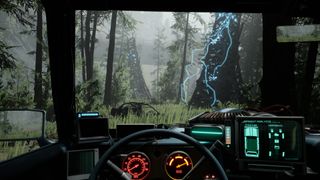Best Survival Game 2024: Pacific Drive
On the road again.

Our favourite survival game of the year wasn't about fighting zombies or monsters or the bitter cold. Instead it's about fighting with your car as you explore a strange land full of mysteries. For more awards, check out our Game of the Year 2024 hub.
Jacob Ridley, Managing Editor, Hardware: Do you ever get that cosy feeling when driving down a road at night? A light rain spattering against the windshield as your windscreen wipers move to and fro with a gentle squeak. That's the feeling Pacific Drive captures. Except there are weird junkyard alien-type-things and mystery manikins.
You might find yourself improving your weaponry or armour in many survival games. Not this one. The only things you're fending off are rust, failing electronics, and years of neglect on a station wagon. A station wagon that is your only companion in the Pacific Northwest and seemingly the thing trying to kill you most of all. A series of increasingly frustrating car-based gaffs mean you're never short of a need to venture into the wilderness looking for materials. For me, that means grabbing a controller, setting my gaming chair to relaxed mode, and dimming the lights. This game's simple controls and gradual pacing make it a great way to take it easy after a long day—a welcome change from some more intense survival mechanics.
Elie Gould, News Writer: I love liminal spaces. The creepy quiet before the storm, its unearthly vibe, and the unsettling feeling that something is waiting for you around every corner. So it should come as no surprise that driving through the pine forests of the Olympic Exclusion Zone was exactly the kind of existential torment that I love to experience in a videogame.
Driving around abandoned villages, down dirt roads, or along vast stretches of tarmac in search of doodads and doohickeys was astonishingly fun. Tethering yourself to the car was a cool new twist on survival mechanics and one that I was happy to explore. The car upgrades and customisation were also intuitive and surprisingly fun, so much so that it actually made me appreciate cars more.

But Pacific Drive's stand-out feature to me was its incredible radio. The tracklist that A Shell in the Pit's producer put together was astoundingly good, and if you haven't listened to the lead song, Ghost on the Road, yet, then I implore you to do so as soon as possible.
Evan Lahti, Strategic Director: Physical props feel so authentic in Pacific Drive, and it makes all the difference. The car is the star, a sophisticated piece of game technology unto itself. When you unscrew a steel body panel, you hear the leffy-loosey whirl of your power drill as the panel jiggles into your hands, ready to be tossed aside, repainted, repaired, or churned into scrap at the corresponding station.
The biggest gaming news, reviews and hardware deals
Keep up to date with the most important stories and the best deals, as picked by the PC Gamer team.
I didn't expect this survival game to also outdo every racing game and repair shop sim in that regard, but the downtime of repairing is such a delightful come-down from the radioactive weirdness you encounter on the road. Even something as mundane as refilling gas feels more than mundane, but something you feel intrinsically motivated to do. I replace the nozzle in its rightful spot every time.
Christopher Livingston, Senior Editor: Hands down, Pacific Drive invented the best car in video game history, and having owned a couple of old, quirky clunkers in my youth, I love the quirk system Ironwood Studio game up with. Drive that old wagon through enough bizarre anomalies and it's gonna start acting weirdly, and diagnosing quirks on the garage computer is a fun challenge. I noticed my headlights keep shutting off, but why? Is it because I turned off my radio or because I closed the trunk? Experimenting to replicate quirks and then trying to explain them to a computer added some welcome puzzle-solving to the driving survival mix.

Jacob earned his first byline writing for his own tech blog. From there, he graduated to professionally breaking things as hardware writer at PCGamesN, and would go on to run the team as hardware editor. He joined PC Gamer's top staff as senior hardware editor before becoming managing editor of the hardware team, and you'll now find him reporting on the latest developments in the technology and gaming industries and testing the newest PC components.
- Elie GouldNews Writer
- Evan LahtiStrategic Director
- Christopher LivingstonSenior Editor

It's been a big year for factory sims, but instead of getting a degree in engineering, I've decided to go back to where it all started for me: modded Minecraft

This co-op survival horror masterpiece is just $2 in the Steam Winter Sale, which could explain why it just hit an all-time high player count of nearly 100k a decade after it launched